How to Take Maximum Advantage of Column-Type Selectivity
LCGC North America
When developing or modifying an LC separation, a common strategy is to change selectivity by choosing a new column. Here’s guidance for making that selection.
How do non-alkylsilica columns provide us an additional dimension of column selectivity?
When developing or modifying a liquid chromatography (LC) separation, one of the biggest challenges is moving peaks around to avoid peak overlap. This process involves a change in the selectivity, α, of the separation. As discussed in a recent series of “LC Troubleshooting” articles (1–3), there are many ways to accomplish this adjustment, one of which is to change the column. When changing columns, usually the goal is find an equivalent column or an orthogonal column. By “equivalent,” we mean a second column that will generate a separation that is acceptably similar to the original column (that is, very similar selectivity), such as when specifying a second column source as an alternative for a routine method. By “orthogonal,” we mean a second column that will generate a separation that is quite different from the one obtained on the original column. A change to an orthogonal column will result in significant differences in α for at least some peak pairs (that is, very different selectivity), often with elution order reversals observed or overlapping peak pairs resolved. An orthogonal column often is desired as a way to check for hidden peaks, as an approach to separate known peak overlaps, or as a screening tool to initially examine the overall complexity of a sample. Seldom does a simple change to an orthogonal column satisfy all separation requirements-instead, one expects that additional adjustment of the chromatographic conditions (for example, solvent type, percent organic, pH, or temperature) will be required before the final method has acceptable resolution for all peaks of interest.
The role of column selectivity was discussed in an earlier “LC Troubleshooting” installment (4). One procedure to quantify differences in column selectivity for reversed-phase LC is the application of the hydrophobic-subtraction (H-S) model, as reviewed recently in LCGC (5) and discussed in more detail elsewhere (6). The review focused on comparison of alkylsilica columns-those with a linear hydrocarbon, most commonly a C8 or C18 phase, bonded to high-purity (“type B”) silica particles. In this installment of “LC Troubleshooting,” we extend that discussion to include several other common non-alkylsilica columns: phenyl, cyano, perfluorophenyl (PFP), and embedded-polar group (EPG) columns. We’ll describe the best way to find equivalent columns if one of these columns is the original column used for comparison, as well as how best to incorporate these columns into the search for an orthogonal column.
There are other approaches to classifying column selectivity in addition to the approach discussed here and in reference 5. Three such approaches are available as free software; their benefits and limitations are reviewed in section 7.5 of reference 6. Two versions of the H-S model approach are available for free on the internet. One is on the United States Pharmacopeial Convention (USP) website (7); the second (8) contains the same data in a different format. Both of these databases contain the same data for nearly 700 reversed-phase columns, but the latter (8) can be more versatile and convenient to use because of its ability to sort data according to manufacturer, bonded phase, and other variables.
It should also be noted that with any of the databases, it is almost always preferable to use columns containing high-purity (“type-B”) silica particles; older, low-purity (“type-A”) silica tends to be much less reproducible and more subject to peak tailing problems, and it is usually difficult to find equivalent type-A columns. Today’s type-B silica columns are highly reproducible from column-to-column and between manufacturing batches (9,10), so results obtained from the databases should be applicable to a given column (same part number) over time.
The Hydrophobic-Subtraction Model for Alkylsilica Columns
The H-S model of column selectivity was reviewed recently (5) and more detail can be obtained from (6), so only a brief summary is given here. The H-S model describes column selectivity for alkylsilica columns as follows:

Here k is the retention factor for a particular solute, kEB is the retention factor for ethylbenzene, the Greek letters (η’, σ’, β’, α’, and κ’) are characteristics of the solutes, and the capital letters (H, S*, A, B, and C) are column parameters. The five terms describing selectivity are i, the hydrophobic interaction between the solute and the column; ii, the resistance of the bonded phase to penetration by bulky molecules; iii, hydrogen bond (H-B) interactions between basic solutes and acidic sites (silanols) in the column; iv, H-B interactions between acidic solutes and proton–acceptor sites on the column; and v, cation exchange between ionized bases and ionized silanol groups in the column. These five interactions are illustrated in Figure 1. Equation 1 estimates retention, k, for a given solute (with known values of η’, σ’, β’, α’, and κ’) within ±1% (one standard deviation, SD) for alkylsilica phases.
Figure 1: Visual interpretation of the five solute–column interactions summarized in equation 1.
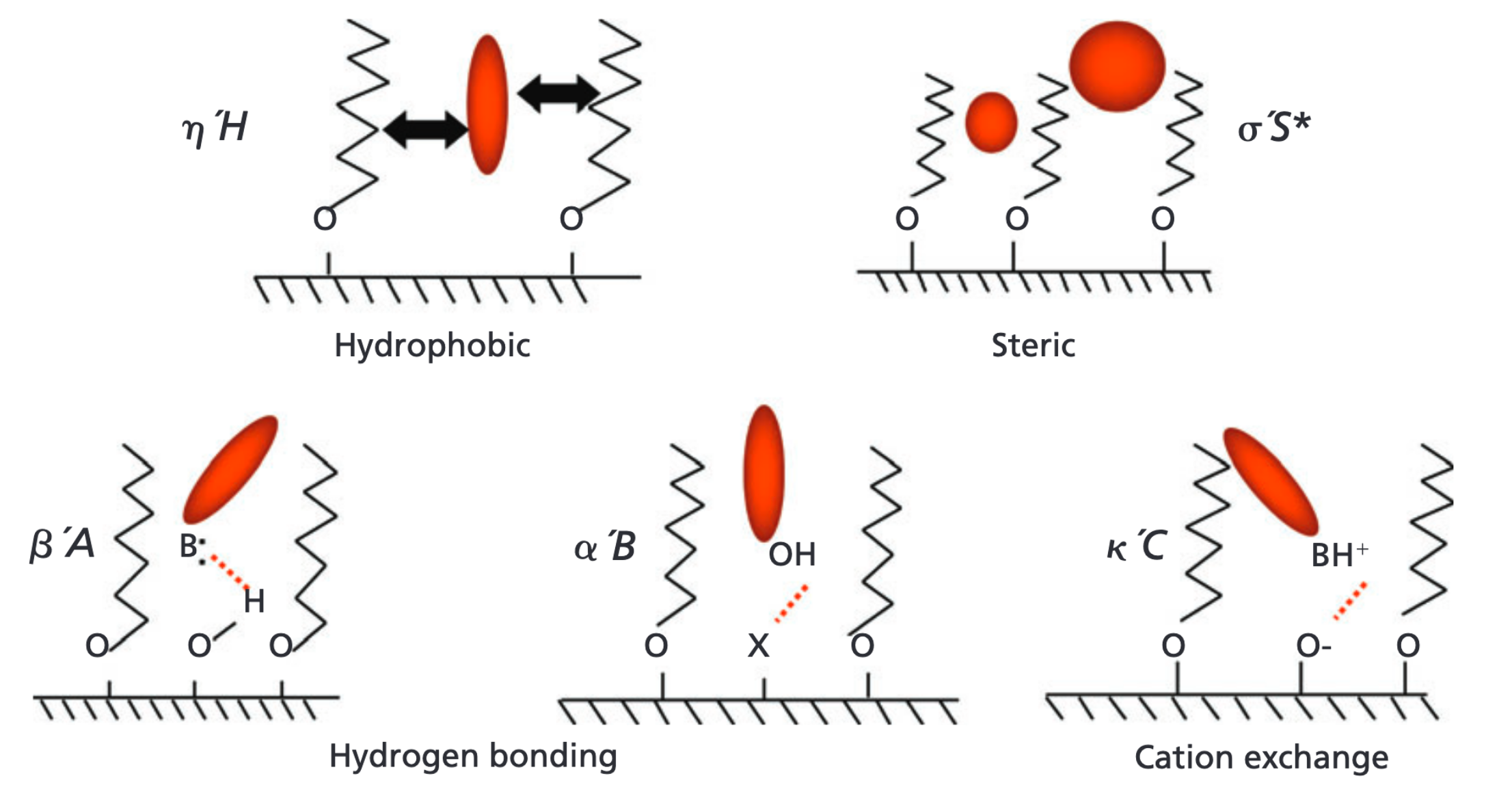
Columns Other than Alklylsilica
The USP database based on the H-S model has been shown to be reliable for selecting alkylsilica columns of either the same or very different selectivity (11,12). But what about other types of columns, such as those with phenyl, cyano, PFP, and EPG stationary phases? The USP classification depends on five column properties or column–sample interactions (equation 1 and Figure 1) that are now well understood (13–15) and “completely” describe selectivity for alkylsilica columns.
Other kinds of columns are known to exhibit these same five interactions, as well as certain additional interactions. The latter are illustrated in Figure 2. Phenyl columns (Figure 2a) can interact with aromatic compounds by π-π interaction, where an electron is transferred from the solute to the phenyl group. Cyano columns can also interact with electron donors by π-π interaction (Figure 2b), and in addition the strong dipole of the cyano group can attract the dipoles in very polar solutes (Figure 2c). PFP columns are capable of both π-π and dipole-dipole interactions, and in addition the fluoro groups have much greater hydrophobicity, to the extent that this can be regarded as an additional selectivity contribution or “interaction.” Finally, EPG columns are capable of a very different kind of column basicity. In addition to the column basicity found in all reversed-phase columns (Figure 2d) that leads to the preferential retention of carboxylic acids, the polar groups in EPG columns can bind both carboxylic acids (Figure 2e) and phenols (Figure 2f).
Figure 2: Solute-column interactions for non-alkylsilica columns in addition to those of equation 1: (a) π-π interactions for a phenyl column, (b) π-π interactions for a cyano column, (c) dipole-dipole interactions for a cyano column, (d) column basicity for all reversed-phase columns (B-term, iv of equation 1), (e) interaction of carboxylic acids with EPG columns, and (f) interaction of phenols with EPG columns.
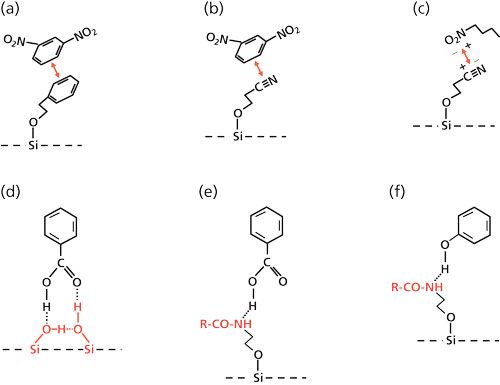
The relative importance of these additional interactions are easily shown by examining the average error in predicted values of k from equation 1 for different column types (Table I). For alkylsilica columns, where equation 1 accounts for all interactions, the accuracy of predictions of k is within experimental error (±1% SD). Phenyl columns, on the other hand, show an average error of 7%, and this is reasonably attributed to the presence of their additional π-π interaction. For cyano columns, the error increases to 10%, which is postulated to be from both π-π and dipole-dipole interactions present in these columns. Similarly, PFP columns have both π-π and dipole-dipole interactions, as well as unusual hydrophobicity, and the error in predicted values of k is further increased to ±15%.
EPG columns have only one additional interaction (between polar groups and the solute), but this interaction leads to an even larger error in values of k (±20%). The likely reason for this larger contribution to k is that EPG columns differ from other columns in the following way. Other column types of a given type always have the same functional group (alkyl, phenyl, cyano, or fluoro), whereas EPG columns come with different interacting groups, such as carbamate, amide, urea, or ether. We might expect that EPG column basicity would vary with the EPG group, and indeed this is so (Table II). It seems probable that these different polar groups are responsible for the ±20% error in predicted values of k.
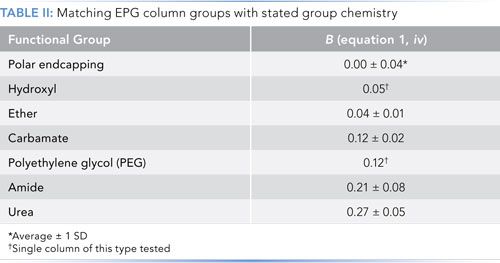
The additional interactions present in these non-alkylsilica columns also lead to further differences (or increases) in column selectivity. These selectivity changes could mean that two columns, one or both of which is not an alkylsilica column, might give small values Fs, yet not be equivalent because of the “extra” interactions beyond those of equation 1. (Fs is the difference in column selectivity discussed along with equation 3 below.) Also, these additional interactions should lead to further differences in selectivity for some samples-that is, “more selective” columns for method development.
So, how can we use what we know about these additional interactions to improve the selection of either equivalent or orthogonal columns? First we’ll review how Fs is useful to characterize alkylsilica columns. Then we will consider the best way to select either an equivalent column or an orthogonal column.
Measuring Column Selectivity Differences for Alkylsilica Columns with Fs
Figure 3 provides a graphical illustration of the concept of column comparison for just three column properties (S*, A, and B). The difference in selectivity can be measured by the distance in three-dimensional space between points for the two columns (red dashed line).
Figure 3: Example of graphic comparison of two columns where only steric, S*, hydrogen bonding to acidic sites on the column, A, and hydrogen bonding to basic sites on the column, B, are important.
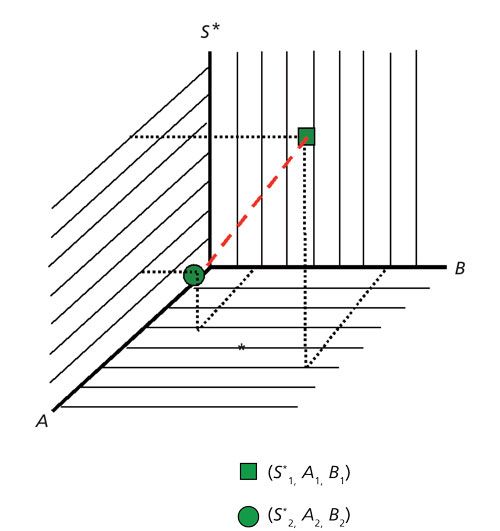
This distance for three variables can be obtained from the Pythagorean theorem:

where Fs is the difference in selectivity, comparable to the distance between the two points in Figure 3, and the subscripted variables correspond to the characteristics of the two columns, 1 and 2. This technique of comparison can be mathematically (but not visually) extended to all five column parameters:

Now we can compare any two columns for which we have measured the column parameters H, S*, A, B, and C. If Fs is small, the columns are similar; if Fs is large, the columns are different. For practical use, values of Fs can be generalized as follows:
- Fs ≤ 3: columns are equivalent for most separations
- 3 < Fs < ~10: columns are likely to be equivalent, especially for samples that contain only a few solutes with resolution, Rs >> 2
- Fs ≥ 100: columns are orthogonal when ionized solutes are present in the sample
- Fs ≥ 35: columns are orthogonal when the sample comprises predominantly non-ionized analytes and values of C in equation 3 are ignored.
For further discussion of the use of Fs in classifying column selectivity for alkylsilica columns, see reference 5.
Selecting an Equivalent Column
The selection of an equivalent alkylsilica column requires no change in the use of present column selection software (either references 7 or 8). The second column (or columns) should be selected with a low value of Fs. For many samples, Fs <10 should prove adequate, as noted above. For more crowded separations, especially with one or more barely resolved peaks, the smaller Fs is, the better. A value of Fs <3 will rarely prove unsuitable to identify an equivalent column.
If a non-alkylsilica column is to be duplicated, small values of Fs are still the first rule. However, obtaining small values of Fs for non-alkylsilica columns will generally prove more difficult, partly because there are fewer columns from which to choose. There is an additional, more serious concern-the additional interactions present in these columns (unrecognized by equation 1) will not have been taken into account. One expedient to minimize this effect is to choose the equivalent column from columns in the database of the same type. So if an equivalent phenyl column is needed, compare the original column only with other columns of the same type (phenyl columns with phenyl columns, and so forth). For example, the ACE 4 phenyl column (Advanced Chromatography Techniques Ltd.) and the Genesis phenyl column (Hichrom/Grace) have Fs = 2.8, so these columns should be equivalent-the Fs value is small and the phase type (phenyl) is the same. This type of column sorting is easy with the database in reference 8. Another consideration to keep in mind is that column types with larger errors in Table I can be more difficult to match in terms of equivalency. So the initial selection of a column during method development generally favors alkylsilica columns. This suggestion contradicts the common practice of optimizing the separation by first choosing a “more selective” column, which often favors the choice of a non-alkylsilica column. In many cases, however, any added selectivity needed for resolution can be provided by adjusting other separation conditions. A logical plan for such selectivity optimization has been described (16).
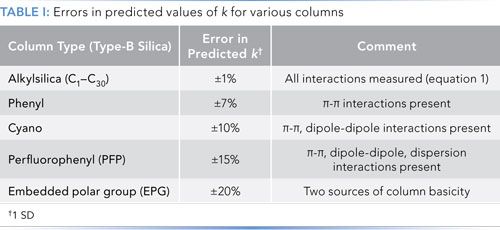
Selecting an Orthogonal Column
The general recommendation for an orthogonal column is one with the largest possible value of Fs, consistent with other column requirements (preferred vendor, stability, and so forth). But this requirement only maximizes differences in the five sample-column interactions described in equation 1 for alkylsilica columns. The additional interactions present in non-alkylsilica columns offer further differences in selectivity that are desirable in an orthogonal column. Table I provides some guidelines on how to exploit these additional interactions. It is desirable to have as many additional interactions present as possible, because then a wider range of samples is likely to exhibit changes in relative separation (values of α), as desired for the orthogonal separation.
The above considerations suggest that the first choice of a phase orthogonal to an alkylsilica column would be a PFP column. Similarly, if the original column is a PFP column, then the orthogonal column should be an alkylsilica column. And in either case, choose the second column with as large a value of Fs as possible.
So far we have assumed that an orthogonal column is needed for single-column, one-dimensional separation. Another situation is the choice of two columns for two-dimensional LC (2D-LC). In this case, we want maximum differences in selectivity for the two columns, which suggests combining two non-alkylsilica columns of different type, where the “extra” interactions present in the two columns are different. From Table I we see that an ideal combination appears to be of a PFP and an EPG column, again with maximum Fs values. However, there are other considerations. For some 2D-LC applications, where the basic column configuration may not change for different samples, column stability and other requirements may predominate.
Summary
We have looked at how the power of the H-S model for measuring column selectivity differences with alkylsilica phases can be extended for non-alkylsilica bonded phases. Specifically, we have seen how the phenyl, cyano, PFP, and EPG phases add π-π, dipole-dipole, and dispersive interactions to the five interaction characteristics of alkylsilica phases summarized in equation 1. When comparing LC columns, our goal generally is to find an equivalent or orthogonal column relative to a column currently in use. For comparison of alkylsilica columns, the Fs value is a sufficient comparison tool, with small Fs values desired for equivalent columns and large values for orthogonal ones. When equivalent columns are desired for non-alkylsilica phases, it is best to select columns of the same phase (for example, two phenyl columns) with small Fs values. To identify maximally orthogonal columns, pick column pairs with a different type of bonded phase (for example, alkylsilica and PFP, or PFP and EPG) and large Fs values. Finally, it should be recognized that using these guidelines will improve, but not guarantee, the likelihood of selecting an equivalent or orthogonal column-the column will need to be tested in the laboratory to see if it meets your criteria.
References
- J.W. Dolan, LCGC North Am.35(3), 170–173 (2017).
- J.W. Dolan, LCGC North Am.35(4), 240–245 (2017).
- J.W. Dolan, LCGC North Am. 35(5), 306–311 (2017).
- J.W. Dolan, LCGC North Am. 29(3), 236–244 (2011).
- J.W. Dolan and L.R. Snyder, LCGC North Am. 34(9), 730–741 (2016).
- L.R. Snyder, J.W. Dolan, D.H. Marchand, and P. W. Carr, Adv. Chromatogr. 50, 360–364 (2012).
- PQRI database at http://www.usp.org/USPNF/columns.htm.
- HPLC Columns database at http://www.hplccolumns.org/database/compare.php.
- U.D. Neue, E. Serowik, P. Iraneta, B.A. Alden, and T.H. Walter, J. Chromatogr. A849, 87–100 (1999).
- M. Kele and G. Guiochon, J. Chromatogr. A 913, 89–112 (2001).
- J.W. Dolan, A. Maule, D. Bingley, L. Wrisley, C.C. Chan, M. Angod, C. Lunte, R. Krisko, J.M. Winston, B. Homeier, D.V. McCalley, and L.R. Snyder, J. Chromatogr. A 1057, 59–74 (2004).
- J. Pellett, P. Lukulay, Y. Mao, W. Bowen, R. Reed, M. Ma, R.C. Munger, J.W. Dolan, L. Wrisley, K. Medwid, N.P. Toltl, C.C. Chan, M. Skibic, K. Biswas, K.A. Wells, and L. R. Snyder, J. Chromatogr. A 1101, 122–135 (2006).
- P.W. Carr, J.W. Dolan, U.D. Neue, and L.R. Snyder, J. Chromatogr. A 1218, 1724–1742 (2011).
- D.H. Marchand, P.W. Carr, D.V. McCalley, U.D. Neue, J.W. Dolan, and L.R. Snyder, J. Chromatogr. A 1218, 7110–7129 (2011).
- P.W. Carr. J.W. Dolan, J.G. Dorsey, L.R. Snyder, and J.J. Kirkland, J. Chromatogr. A 1395, 57–64 (2015).
- L.R. Snyder and J.W. Dolan, J. Chromatogr. A 1302, 45–54 (2013).
John W. Dolan

“LC Troubleshooting” Editor John Dolan has been writing “LC Troubleshooting” for LCGC for more than 30 years. One of the industry’s most respected professionals, John is currently a principal instructor for LC Resources in McMinnville, Oregon. He is also a member of LCGC’s editorial advisory board. Direct correspondence about this column via e-mail to LCGCedit@ubm.com

Dwight Stoll is the incoming editor for “LC Troubleshooting,” effective November 2017. Stoll is an associate professor and co-chair of chemistry at Gustavus Adolphus College in St. Peter, Minnesota. His primary research focus is on the development of 2D-LC for both targeted and untargeted analyses. He has authored or coauthored 48 peer-reviewed publications and three book chapters in separation science and more than 95 conference presentations. He is also a member of LCGC’s editorial advisory board.

Lloyd Snyder is a retired chromatographer, formerly a principal at LC Resources. He is one of the developers of the hydrophobic-subtraction model for the characterization of reversed-phase column selectivity (with John Dolan, Peter Carr, and others). He was associated with HPLC method development for both normal-phase and reversed-phase HPLC (including DryLab software), and for gradient elution (the linear-solvent-strength model). He is the author or coauthor of nine books on chromatography, including the 3rd edition of Introduction to Modern Liquid Chromatography (2010, with Jack Kirkland and John Dolan).

Polysorbate Quantification and Degradation Analysis via LC and Charged Aerosol Detection
April 9th 2025Scientists from ThermoFisher Scientific published a review article in the Journal of Chromatography A that provided an overview of HPLC analysis using charged aerosol detection can help with polysorbate quantification.
Removing Double-Stranded RNA Impurities Using Chromatography
April 8th 2025Researchers from Agency for Science, Technology and Research in Singapore recently published a review article exploring how chromatography can be used to remove double-stranded RNA impurities during mRNA therapeutics production.














